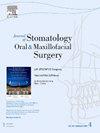不同矢状畸形和垂直畸形的舌骨三维参数与咽部气道尺寸之间的相关性。
IF 1.8
3区 医学
Q2 DENTISTRY, ORAL SURGERY & MEDICINE
Journal of Stomatology Oral and Maxillofacial Surgery
Pub Date : 2024-10-01
DOI:10.1016/j.jormas.2024.101994
引用次数: 0
摘要
研究目的本研究旨在探讨舌骨(HB)和咽气道间隙(PAS)的三维(3D)测量值与矢状和垂直错颌畸形之间的关系:将总共 368 个锥形束计算机断层扫描(CBCT)扫描结果分为三个骨骼组(I 级、II 级和 III 级),并按垂直生长模式(低发散、正常发散和高发散)进行细分。用 InVivo 6.0.3 和 Dolphin 11.8 软件测量了包括鼻咽、口咽、下咽和总气道空间在内的 PAS 尺寸的表面积、体积、最小收缩面积(MCA)、长度和宽度,并对 HB 位置和尺寸进行了三维分析。数据采用双因素方差分析和Bonferroni事后检验,P≤0.05为显著:研究发现,骨骼Ⅲ级和生长模式低发散的患者舌骨矢状位最高,而骨骼Ⅱ级和生长模式高发散的患者舌骨长度最低。骨骼Ⅲ级患者的鼻咽气道间隙宽度明显较低,而超发散型患者的鼻咽气道间隙容积和面积均较低。口咽和下咽的尺寸也受骨骼分级和生长模式的影响,超分化患者的数值最低。咽部总体积、面积和最小收缩面积也受到影响,高分化患者的数值最低,骨骼分级为II级的患者最小收缩面积最低:结论:咽部气道尺寸和舌骨参数随畸形而变化。舌骨的位置会影响气道,识别气道阻塞和睡眠呼吸障碍的高危患者。本文章由计算机程序翻译,如有差异,请以英文原文为准。
Correlation between the three-dimensional hyoid bone parameters and pharyngeal airway dimensions in different sagittal and vertical malocclusions
Objective
This study aimed to explore the relationship between three-dimensional (3D) measurements of the hyoid bone (HB) and pharyngeal airway space (PAS) in relation to sagittal and vertical malocclusion.
Methods
A total of 368 cone-beam computed tomography (CBCT) scans were classified into three skeletal groups (Class I, II, and III) and subdivided by vertical growth patterns (hypodivergent, normodivergent, and hyperdivergent). PAS dimensions, including nasopharyngeal, oropharyngeal, hypopharyngeal, and total airway spaces, were measured in surface area, volume, minimum constricted area (MCA), length, and width, HB position and dimension were analyzed in 3D using InVivo 6.0.3 and Dolphin 11.8 software. Data were analyzed using two-way ANOVA, and Bonferroni post-hoc tests, with P ≤ 0.05 considered significant.
Results
The study found that patients with skeletal Class III and hypodivergent growth pattern had the highest sagittal position of the hyoid bone, while those with skeletal Class II and hyperdivergent pattern had the lowest hyoid length. Nasopharyngeal airway space width was significantly lower in skeletal Class III patients, while volume and area were lower in hyperdivergent patients. Oropharyngeal and hypopharyngeal dimensions were also affected by skeletal class and growth pattern, with hyperdivergent patients having the lowest values. Total pharyngeal volume, area, and minimum constricted area were also affected, with hyperdivergent patients having the lowest values and skeletal Class II patients having the lowest minimum constricted area.
Conclusion
Pharyngeal airway dimensions and hyoid bone parameters vary with malocclusions. The hyoid bone's position influences the airway, identifying patients at risk for airway obstruction and sleep-disordered breathing.
求助全文
通过发布文献求助,成功后即可免费获取论文全文。
去求助
来源期刊

Journal of Stomatology Oral and Maxillofacial Surgery
Surgery, Dentistry, Oral Surgery and Medicine, Otorhinolaryngology and Facial Plastic Surgery
CiteScore
2.30
自引率
9.10%
发文量
0
审稿时长
23 days
 求助内容:
求助内容: 应助结果提醒方式:
应助结果提醒方式:


